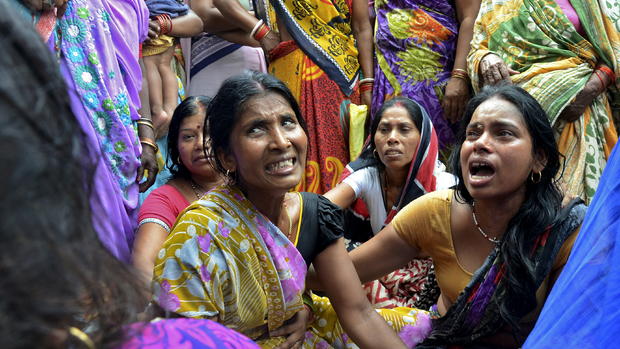Search continues for U.S. copter, Nepal quake victims
CHAUTARA, Nepal - Hundreds of Nepalese soldiers and four American military helicopters continued the hunt Wednesday for a U.S. Marine Corps helicopter that disappeared Tuesday carrying six Marines and two Nepalese soldiers while delivering disaster aid in Nepal's northeast.
The helicopter was part of the U.S. government's aid effort in Nepal, which was just beginning to rebuild after a devastating April 25 earthquake when it was hit Tuesday by magnitude-7.3 quake. Tuesday's earthquake killed at least 65 people, injured nearly 2,000 and caused landslides that blocked roads and slowed the delivery of relief supplies.
CBS News correspondent Seth Doane reports there are currently about 300 U.S. troops in Nepal, and they've been using the choppers to ferry relief supplies to hard-to-reach regions.
There have been no indications the missing aircraft crashed, but a Nepalese military officer told the Reuters news agency he believed the UH-1Y Huey had gone down in a river.
"The info we have is that it is down in one of the rivers, but none of the choppers has seen it yet," Nepalese Army Major Rajan Dahal told Reuters. He did not provide any information as to what led to the suspicion that the U.S. helicopter had crashed in a river.
Contacted Wednesday morning by CBS News, a spokesman for the U.S. military operation in Nepal said he could neither confirm nor deny Dahal's information.
Home ministry official Laxmi Dhakal said Wednesday that army helicopters were scouring the Sunkhani area, nearly 50 miles northeast of Kathmandu, for the missing helicopter.
Meanwhile, officials with bullhorns walked through the quake-damaged streets of Chautara, a small Nepal town, calling for people to leave the damaged buildings.
Officials walked the rubble-strewn streets of Chautara calling out through bullhorn: "There is danger! Leave the buildings!"
Most people, though, had fled into the open the day before, and had spent the night in tents or under plastic tarps.
Tuesday's quake battered Chautara, a foothills town that became a hub for rescuers and humanitarian aid after the first earthquake. Officials there said at least three people had died Tuesday and more than 60 were injured.
Tuesday's magnitude-7.3 quake, centered between Kathmandu and Mount Everest, struck hardest in the foothills of the Himalayas. Most of the 65 people confirmed dead by Wednesday morning were in Dolakha district, northeast of Kathmandu, said the district's chief administrator, Prem Lal Lamichane.
"People are terrorized. Everyone is scared here. They spent the night out in the open," Lamichane said, adding the administration was running out of relief material.
He asked the government to send more helicopters and supplies, and said there were many injured people stranded in villages.
Tuesday's quake also left nearly 2,000 injured, according to the Home Ministry's latest count. But that toll was expected to rise as reports trickled in of people in isolated Himalayan towns and villages being buried under rubble, according to the U.N.'s Office for the Coordination of Humanitarian Affairs.
Tremors radiated across parts of Asia. In neighboring India, at least 16 people were confirmed dead after rooftops or walls collapsed onto them, according to India's Home Ministry. Chinese media reported one death in Tibet.
The magnitude-7.8 earthquake that hit April 25 killed more than 8,150 people and flattened entire villages, leaving hundreds of thousands homeless in the country's worst-recorded quake since 1934. The U.S. Geological Survey said Tuesday's earthquake was the largest aftershock of that quake.
But while Tuesday's quake was terrifying and deadly, it was significantly less powerful than April's and occurred deeper in the Earth. Working from U.S. Geological Survey data, calculations done by University of Michigan earthquake geophysicist Eric Hetland indicated that about 65,000 people were exposed to "violent" shaking Tuesday - compared to 1.5 million on April 25.
While the first quake exposed just under 8,000 square kilometers (3,100 square miles) to severe shaking, Tuesday's exposed only about 660 square kilometers (255 square miles) to the same intensity, he said. And that, he added, came in a region with lower population density and no urbanized areas.
"That's really the key difference, in terms of how the earthquake affects people," Hetland said.
The first quake also drove many people from damaged homes, and officials in Kathmandu and other towns reported the collapse Tuesday of empty buildings.
Impoverished Nepal appealed for billions of dollars in foreign aid after the first quake, as well as medical experts to treat the wounded and helicopters to ferry food and temporary shelters to hundreds of thousands left homeless amid unseasonal rains.
In Washington, Navy Capt. Chris Sims said the missing Huey helicopter was conducting disaster relief operations near the Nepal town of Charikot.
A nearby Indian helicopter heard radio chatter about a possible fuel problem, said U.S. Army Col. Steve Warren. The Huey, carrying tarps and rice, had dropped off supplies and was headed to a second site when contact was lost, he said, adding that there has been no smoke or other signs of a crash.
Due to the rugged terrain, the helicopter could have landed in an area where the crew was unable to get a beacon or radio signal out, Warren said.
In the capital, frightened residents who had returned to their homes only a few days ago had to again set up tents Tuesday night to sleep in empty fields, parking lots and on sidewalks.
"Everyone was saying the earthquakes are over. ... Now I don't want to believe anyone," said 40-year-old produce vendor Ram Hari Sah.
